Time to concede. The central heating is now on and warm wooly jumpers have made their comeback. Quite unbelievably, winter with its festivities is almost on our doorstep. The barrage of ‘merry’ adverts has long started, with vast ranges of seasonal wares ubiquitously on offer. Imminently, we’ll be treated to that pinnacle of seasonal delights; chronic Christmas jingles blaring from all places retail. Yet, despite the expeditious onslaught of colder temperatures, the Greenhouse borders still look lovely. The borders are now respectfully nearing their winter slumber, though only two weeks prior, flowers were still rife.
This year, the perseverance of flowering plants in the Greenhouse borders has been particularly impressive. Naturally, the weather is primarily responsible. However, one hopes the border’s flowering longevity, is to some degree down to very minor gardening dexterity on the part of yours truly. Over the years, plants have been carefully selected and evaluated, in addition to the application of (so described by Colin Crosbie), ‘border maintenance techniques’. It seems that the work is paying off as the borders are ‘working’ much later into/beyond the season. Deadheading and adequate staking has certainly helped extend the season, but more so, the Chelsea Chop. Phlox, Eupatorium, Sedum, Echinacea and Asters were still in bloom until about two weeks ago. Furthermore, continued cutting back of spent foliage of plants such as; Foeniculum Vulgare (green & bronze), Astrantia, Allium Fistulosum, Hardy Geranium and Alchemilla Mollis, ensured that the borders remained ‘fresh’ much longer.
Some plants fare better than others when it comes late flowering potential and over the years some favourites have surfaced. Attempts to limit this list to ten plants, failed miserably. Therefore, in no particular order (as also proved too difficult), my top fifteen;
Favourite fifteen late flowering plants
Critical for this listing is, extended flowering successfully late and/or ‘beyond’ the season. Therefore not necessarily appealing autumn colouring or beautiful seed heads. Even though for many of those listed below, these latter delights will follow later.

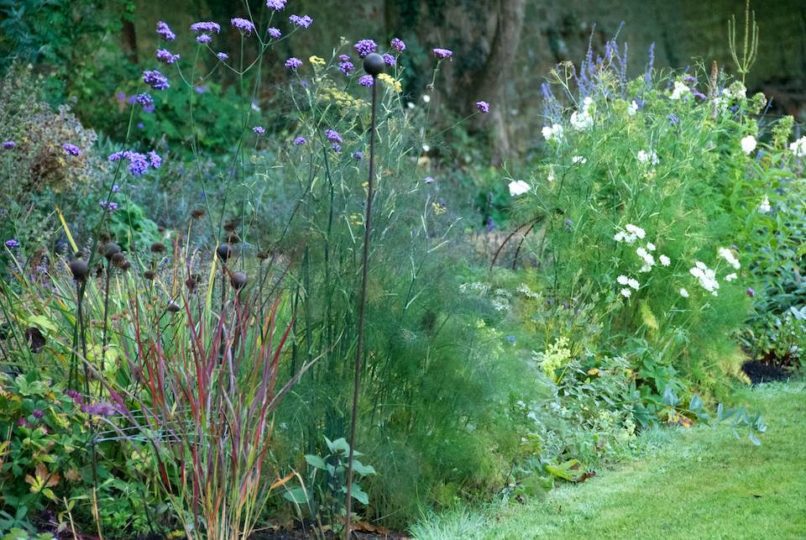


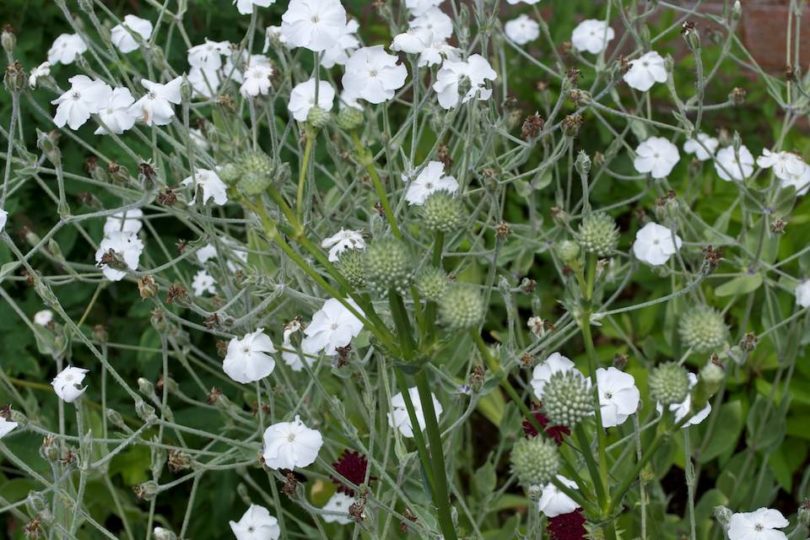
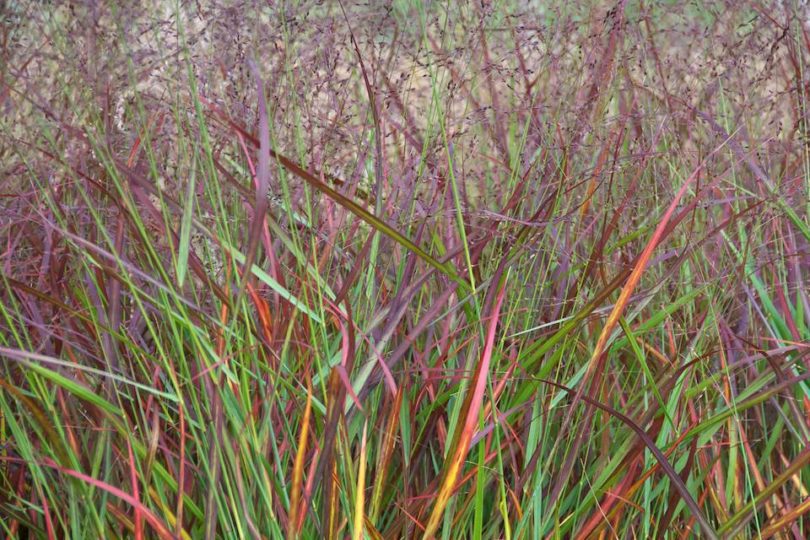
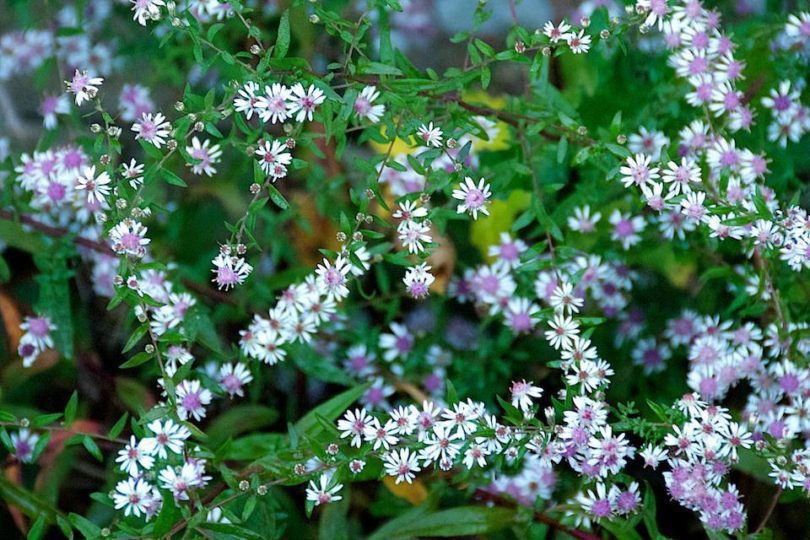



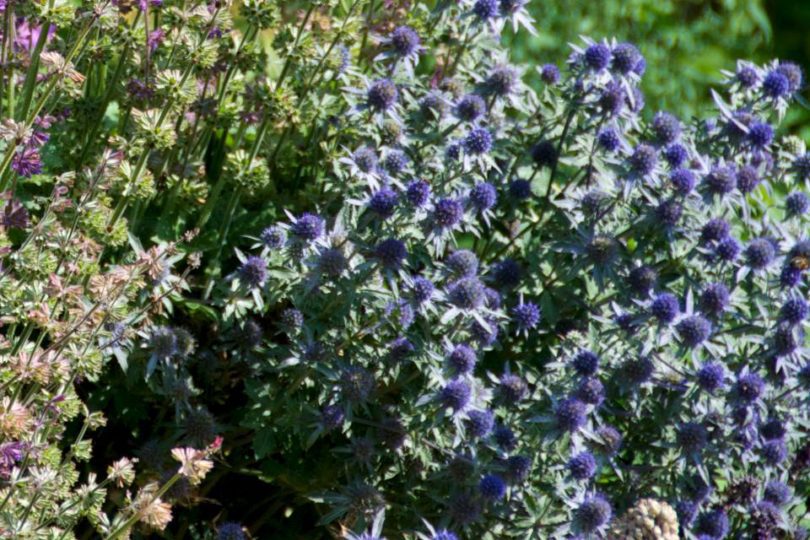
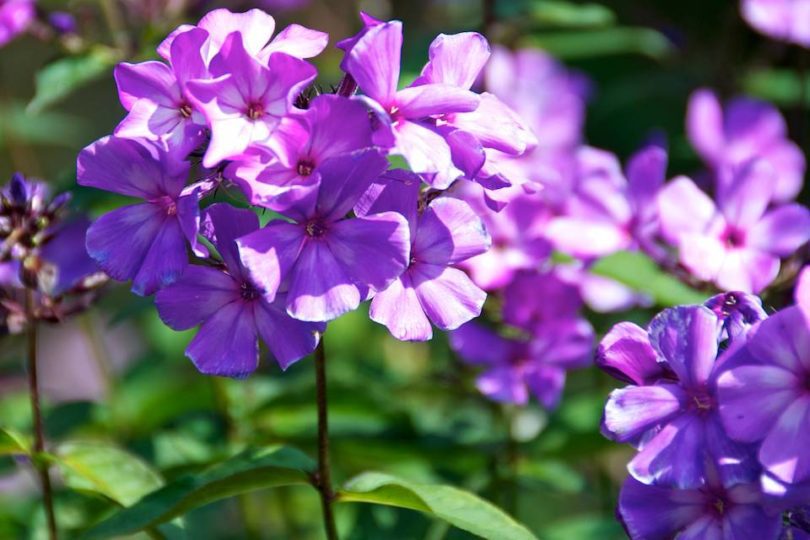
(1) Ageratina altissima Chocolate
Also known as Eupatorium Chocolate or White Snakeroot, this has to be one of my favourite plants. Tall dark purple foliage throughout spring and summer, and in autumn covered with a mass of tiny white flowers. By far the latest flowering plant in the borders. Admittedly, in the past I was never too fond of its flowers, having planted it primarily for its foliage. Though, I have come to love its profuse white flowers, as do the pollinators whom must be getting strapped for choice this late in the season. Propating is easy through cuttings, but as it grows so quickly, splitting the plant is my preferred route. Interestingly, the purple foliage colour is very much dependent on soil conditions. Drier soil, will result in its colour fading to a green/gray. Moister soil will result in the plumpest of purple colour foliage. The Ageratina Altissima can also be grown very successfully in (large) pots, though be prepared to split and re-pot every couple of years.
(2) Verbena Bonairiensis
Probably a favourite for many, and personally find it crucial to the border at this time of year. Terrifically hard working plant, that responds well to dead heading. The biggest and hence most productive plants in the borders, are those that were collected as tiny young plants (super self-seeder), potted up and kept in the greenhouse over winter for subsequent planting in spring. Our mid/end summer is never quite hot enough for the Verbena to grow to its true potential, though that may just be our odd weather conditions. As they are borderline hardy, having spare plants for supplement planting is always useful. Other varieties in the border include; Verbena Hastata and tall Verbena Lavender Spires, the latter of which is a serious contender for this listing.
(3) Eupatorium Maculatum
Part of the Asteraceae family, a brilliantly statuesque plant with lovely pink/purple flowers, providing great depth to the borders. Great plant, very much the back bone of the borders. Responds very well to the Chelsea Chop and is much loved by an array of pollinators. A recent purchase; the slightly larger variety Eupatorium Atropurpureum Riesenschirm.
(4) Phlox
Prior to administering the Chelsea Chop, Phlox would not appear on this list. The early June cut has meant that they really only started flowering in September. Their addition here is therefore with the caveat of needing the chop. The Greenhouse borders include; Phlox Paniculata Blue Paradise, Phlox Paniculata David and two new recent acquisitions; Phlox Paniculata Dusterlohe and Phlox Paniculata Eva Cullum. Dusterlohe being my colour gamble as it is described in ‘Planting the Natural Garden’ as having an ‘alarmingly brilliant lilac-pink color, that makes the phlox extremely ugly and incomparably beautiful at the same time’.
(5) Vernonia crinita ‘Mammuth’
Surprisingly uncommon plant in herbaceous borders, but a wonderful new addition to ours. Still a young plant, bought last year impulsively at a Crocus Open Day, so has some way to go but delighted with its progress and addition to the border. The Vernonia’s young foliage do seem tasty to suspected sluggies, so do watch over it in spring.
(6) Eryngium
There are over 200 species of Eryngium, of which we have three; Eryngium Bourgatii with its variegated leaves, the tall Eryngium Yuccifolium, and the annoyingly rare in nurseries; Eryngium x Tripartitum. The latter having a wonderful upright habit, and is packed with blue/violet flowering spikes. Through personal experience, Eryngiums proved tricky. Quite a few succumbed over the years, and those that survived took time to settle. Furthermore, propagation from seed has not been successful. Root cuttings seems to be an option, though as the plants took so much time to get established, one is somewhat reluctant to disturb their roots. Despite any hardship, certainly worth growing though, particularly for late flowering and for wonderful seed head display in winter. A fellow gardener in the US has written a great comprehensive article on this genus, with details about the various species. Certainly a recommended read.
(7) Sedum
I love Sedums, particularly when planted in rows or large batches. Sedums in particular, benefit from the Chelsea Chop, which despite rendering them somewhat smaller (plant & flower), grow wonderfully upright, with no flopping over what so ever. The resulting Sedum ‘herbage’ from the Chelsea Chop makes great cutting material, many of which are now happily growing in respective pots. The borders include; Sedum Matrona, Sedum Spectabile Brilliant and the aptly named Sedum Herbstfraude.
(8) Asters
Admittedly a late edition to the borders. As there are so many varieties of Aster, it was just rather difficult to choose. Aster Little Carlow and Aster Latiferflorus Lady in Black, were planted last year and their addition to the borders is delightful. As popular as these proved to be, another was swiftly added; Aster Umbellatus. They flowered profusely until just two weeks, with Little Carlow being the first to opt for winter slumber. Pollinators are potty for them, so certainly a recommended addition to any border.
(9) Cirsium Rivulare Atropurpureum
Commonly known as the Brook Thistle, this statuesque plant is a must for long continued startling crimson colour. After the initial flowering period, the entire plant is sheered, after which one enjoys many additional weeks of flowering. It may just be our soil, but continued splitting of the plant has been required as it quickly grows into a huge clump. Though the flower is tall and whispy, the plant itself can become very large, with long leaves capable of smothering its neighbours. Splitting is easily done though, as have found that this plant does not require kid glove treatment. Despite appearances, Cirsium Rivulare does not produce seed.
(10) Panicum Virgatum Rehbraun
Great plant, the first grass to be introduced to the borders. Brilliant late summer/autumn colour, growing to approximately one meter in height. Some Twittering gardeners are critical of its hardiness, but as it is their first year in the border I am unable to confirm. Naturally, one hopes they make it through the winter to prove any disconcerted gardeners wrong.
(11) Tricyrtis Formosana & Hirta
Also known as Toad Lilies, or as on the Continent; ‘Poor man’s Orchid’. The border includes; Tricyrtis Formosana Dark Beauty and Tricyrtis Hirta. Easily propagated from cuttings in the spring. They prefer partial to full shade and moist soil. Ours are not that lucky and are planted in partial shade/full sun, but are thriving. In hot weather, we do make sure they get enough water though.
(12) Lychnis Coronaria
Biennial plant, that never seems to cease flowering. We have the white variety, grown successively from the plant’s generously bestowed seed. A batch of seedlings is now ready to be re-potted in time for spring planting. Deadheading will probably be successful for this plant, though as there are so many flowers, have never attempted to.
(13) Japanese anenome
The pink variety growing profusely in our garden is unknown as the plants came with house, purchased over 60 yrs prior. The border houses their offspring, along with newly added September Charm variety. Fabulous plant, terribly unfussy but always terribly generous in its annual display of elegantly bobbing flowers. Wonderful upright habit, requiring no staking and despite their elegant appearance, they can take on any wind storm. Note, they do seem to sulk when being moved, so ensure planting in its rightful place. Similarly, when splitting plants, be patient as it will take time for them to re-establish.
(14) Perovskia Blue Spires
Almost Lavender-esque, yet much taller. First seen in Oudolf’s private garden & nursery in Hummelo in the Netherlands many years ago, this plant with its attractive silvery green foliage, and late blue/violet flowers is crucial in the border. The mighty Oudolf, present the day we visited, highly recommended the Perovskia. ‘Don’t water it,’ he said, ‘they like it dry’. I never dared tell him of our wet weather and thick claggy soil. Despite the conditions, the plants thrive in our borders. Note, they can grow rather large, so for some end of season pruning includes a severe crew cut, almost right down to ground level. Propagating Perovskia from cutting is quite easy, though be sure to incorporate ample sand and grit for the drainage to make Oudolf happy.
(15) Hydrangea Quercifolia and Aspera
Having lost its identification tag, I am pathetically unable to share the exact type of Hydrangea Quercifolia growing in the border. Originally purchased to sit elegantly in a pot in London, this little hydrangea moved to the country. It’s thriving, so much so, that every spring it is pruned back very hard indeed. Pruning affects the size of the flowers mind; the harder you prune, the smaller the flowers. However, the smaller flowers makes the plant more upright as the weight of the flowers is drastically reduced. In addition to the mystery Quercifolia, the borders also include Hydrangea Aspera Villosa. This hydrangea seems more susceptible to frost damage, as last winter its lovely network of branches succumbed completely. Thankfully, it revived, growing lovely new green shoots in spring from its base. The flowers of the Hydrangea Aspera Villosa, look just lovely paired with Thalictrum Delavayi.
Which are your late summer/autumn flowering favourites?
